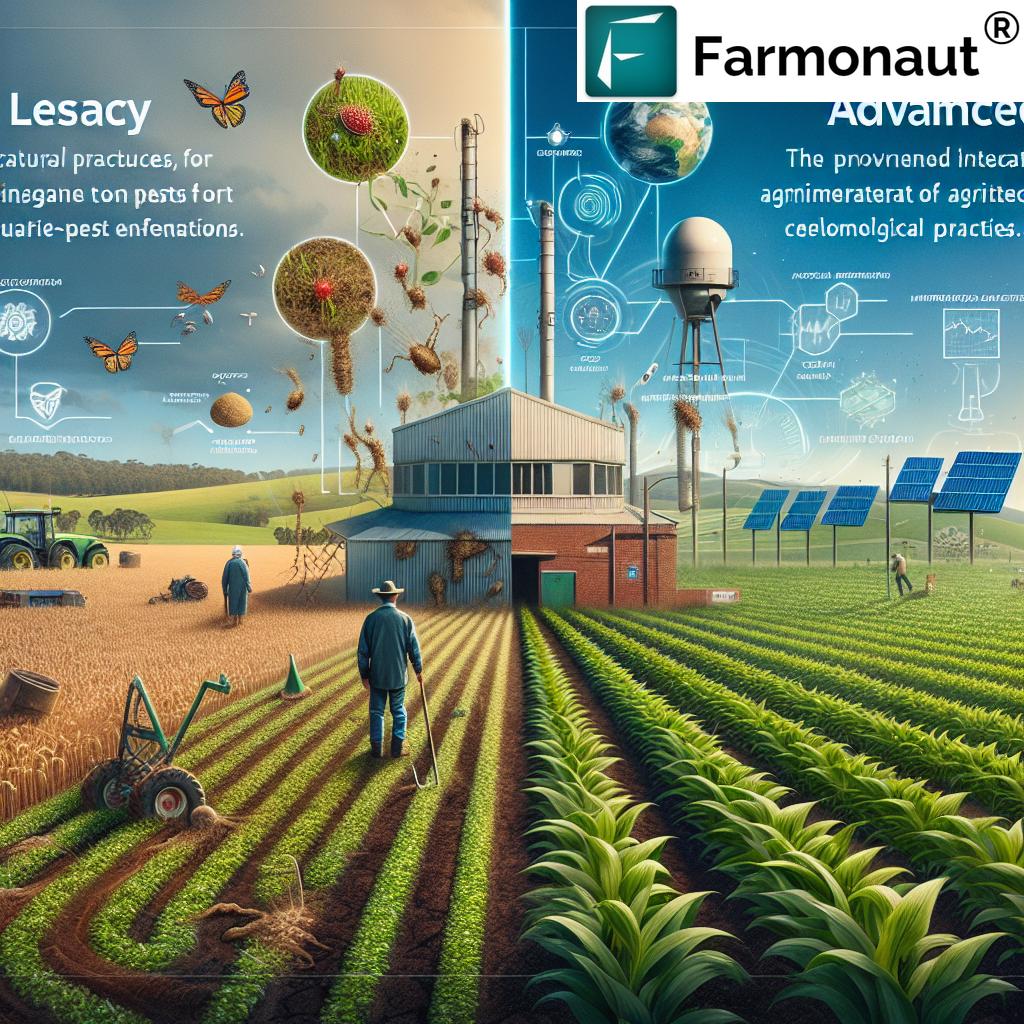Revolutionizing Australian Agriculture: 2024 Crop Protection Innovations and Climate Change Adaptations
“Precision agriculture technologies can increase crop yields by up to 30% while reducing water usage by 50%.”
As we step into 2024, the landscape of Australian agriculture is undergoing a remarkable transformation. In this comprehensive exploration, we’ll delve into the cutting-edge crop protection innovations and climate change adaptations that are reshaping the future of farming in Australia. From the latest advancements in plant biotechnology to the revolutionary impact of precision agriculture, we’re witnessing a new era in crop science and sustainable farming practices.
The Evolution of Crop Protection in Australia
The Australian agricultural sector has always been at the forefront of innovation, adapting to the unique challenges posed by our diverse climate and ecosystems. As we navigate the complexities of climate change and the growing demand for sustainable food production, the importance of advanced crop protection strategies has never been more critical.
In 2024, we’re seeing a convergence of traditional farming wisdom with cutting-edge technology, creating a synergy that promises to revolutionize how we grow, protect, and harvest our crops. Let’s explore the key areas where these innovations are making the most significant impact.

Precision Agriculture: The Game-Changer
Precision agriculture has emerged as a cornerstone of modern farming practices in Australia. By leveraging advanced technologies, farmers can now make data-driven decisions that optimize resource use and maximize crop yields. Here’s how precision agriculture is transforming the industry:
- Satellite-Based Crop Monitoring: Companies like Farmonaut are at the forefront of this revolution, offering satellite-based farm management solutions that provide real-time insights into crop health, soil moisture levels, and vegetation indices.
- Drone Technology: Unmanned aerial vehicles equipped with multispectral cameras are being used to conduct detailed crop surveys, identify pest infestations, and assess plant health with unprecedented accuracy.
- IoT Sensors: A network of Internet of Things (IoT) sensors deployed across fields provides continuous data on soil conditions, weather patterns, and crop growth stages, enabling proactive management decisions.
The integration of these technologies allows for targeted application of fertilizers, pesticides, and water, significantly reducing waste and environmental impact while boosting productivity.
Plant Biotechnology: Engineering Resilience
The realm of plant biotechnology has seen remarkable advancements in recent years, with Australian scientists at the forefront of developing crops that can withstand the harsh realities of climate change. Some key developments include:
- Drought-Resistant Varieties: Through genetic engineering and selective breeding, researchers have created crop varieties that can thrive with minimal water, a crucial adaptation for Australia’s arid regions.
- Pest-Resistant Crops: Biotechnology has enabled the development of plants with built-in resistance to common pests, reducing the need for chemical pesticides and promoting more sustainable farming practices.
- Nutrient-Enhanced Crops: Scientists are working on enhancing the nutritional profile of staple crops, addressing both food security and public health concerns simultaneously.
These biotechnological innovations are not only improving crop yields but also contributing to the overall resilience of Australia’s agricultural sector in the face of climate uncertainties.
Climate Change Adaptations: Preparing for the Future
“Climate-resilient crop varieties developed through biotechnology can withstand temperature fluctuations of up to 5°C.”
The impact of climate change on Australian agriculture cannot be overstated. As we experience more frequent extreme weather events, from prolonged droughts to intense heatwaves, the need for adaptive strategies has become paramount. Here’s how the industry is responding:
- Climate-Smart Agriculture: This approach integrates climate change adaptation and mitigation into agricultural strategies, focusing on sustainable intensification of production systems.
- Water Conservation Techniques: Innovative irrigation systems, such as subsurface drip irrigation and precision sprinklers, are being widely adopted to maximize water efficiency.
- Diversification of Crops: Farmers are increasingly diversifying their crop portfolios to spread risk and improve resilience against climate-related crop failures.
By embracing these adaptations, Australian farmers are not only safeguarding their livelihoods but also contributing to global food security in an era of climate uncertainty.

Resistance Management: Staying Ahead of the Curve
As pests and diseases evolve, so too must our strategies to combat them. Resistance management has become a critical component of crop protection in 2024. Here’s how Australian agriculture is tackling this challenge:
- Integrated Pest Management (IPM): This holistic approach combines biological, cultural, and chemical control methods to manage pests effectively while minimizing environmental impact.
- Rotational Strategies: Implementing crop rotation and alternating pesticides with different modes of action helps prevent the development of resistant pest populations.
- Biocontrol Agents: The use of natural predators and parasites to control pest populations is gaining traction as a sustainable alternative to chemical pesticides.
By adopting these strategies, Australian farmers are not only protecting their crops but also preserving the efficacy of valuable crop protection tools for future generations.
Agritech Solutions: Empowering Farmers
The rise of agritech solutions is democratizing access to advanced farming techniques and data-driven insights. Companies like Farmonaut are at the forefront of this revolution, offering a range of tools that empower farmers to make informed decisions:
- AI-Powered Advisory Systems: Machine learning algorithms analyze vast amounts of data to provide personalized recommendations for crop management, pest control, and resource allocation.
- Blockchain for Traceability: Implementing blockchain technology in agriculture ensures transparency and traceability throughout the supply chain, from farm to table.
- Mobile Applications: User-friendly apps provide farmers with real-time access to critical information and decision-support tools, regardless of their location.
These technological advancements are not just improving efficiency; they’re transforming the very nature of farming, making it more accessible, sustainable, and profitable.
Explore Farmonaut’s innovative solutions:
Environmental Stewardship: Balancing Production and Conservation
As we strive for increased agricultural productivity, the importance of environmental stewardship cannot be overstated. In 2024, we’re seeing a strong emphasis on practices that promote both food security and ecological sustainability:
- Conservation Agriculture: Techniques such as minimal tillage, crop rotation, and cover cropping are being widely adopted to improve soil health and biodiversity.
- Precision Chemical Application: Advanced spraying technologies ensure that crop protection products are applied only where and when needed, minimizing environmental impact.
- Carbon Sequestration: Innovative farming practices that enhance soil carbon storage are gaining recognition as a valuable tool in mitigating climate change.
These environmental safeguards are not just beneficial for the planet; they’re essential for the long-term viability of Australian agriculture.
Policy and Regulation: Shaping the Future of Australian Agriculture
The regulatory landscape plays a crucial role in driving innovation and ensuring the responsible development of agricultural technologies. In 2024, we’re seeing significant policy developments that are shaping the industry:
- Biotechnology Regulations: Updated frameworks are providing clearer pathways for the development and approval of genetically modified crops, balancing innovation with safety concerns.
- Climate Change Policies: Government initiatives are incentivizing farmers to adopt climate-smart practices and invest in renewable energy solutions for their operations.
- Data Privacy and Ownership: New regulations are addressing the complex issues surrounding agricultural data, ensuring that farmers maintain control over the information generated on their farms.
These policy developments are creating an environment that fosters innovation while safeguarding the interests of farmers and consumers alike.
The Role of Farmonaut in Australia’s Agricultural Future
As we navigate the complexities of modern agriculture, platforms like Farmonaut are playing an increasingly vital role. By providing farmers with access to satellite-based crop monitoring, AI-driven insights, and advanced analytics, Farmonaut is empowering Australian farmers to make data-driven decisions that optimize their operations.
Some key features of Farmonaut that are particularly relevant to Australian agriculture include:
- Real-time Crop Health Monitoring: Using satellite imagery to provide up-to-date information on crop health, allowing for timely interventions.
- Weather Forecasting: Accurate, localized weather predictions to help farmers plan their activities and mitigate climate-related risks.
- Resource Management Tools: Features that help optimize water usage, fertilizer application, and other crucial resources.
For more information on how Farmonaut can benefit your farming operations, visit their API Developer Docs or explore their API services.
2024 Australian Crop Protection Innovations and Climate Change Adaptations
| Innovation Category | Technology/Practice | Benefits | Climate Change Impact |
|---|---|---|---|
| Agritech | Satellite-Based Crop Monitoring | Real-time crop health insights, optimized resource management | High |
| Biotechnology | Drought-Resistant Crop Varieties | Increased yield stability, reduced water consumption | High |
| Precision Agriculture | Variable Rate Technology | Targeted input application, reduced environmental impact | Medium |
| Resistance Management | Integrated Pest Management | Sustainable pest control, reduced chemical usage | Medium |
| Climate Adaptation | Climate-Smart Agriculture | Improved resilience, sustainable intensification | High |
Looking Ahead: The Future of Australian Agriculture
As we look towards the future, it’s clear that Australian agriculture is on the cusp of a new era. The innovations and adaptations we’ve explored in this blog post are just the beginning. With continued investment in research and development, and a commitment to sustainable practices, Australian farmers are well-positioned to meet the challenges of climate change and food security head-on.
The integration of advanced technologies, from satellite monitoring to AI-driven analytics, will continue to drive efficiency and productivity gains. At the same time, a growing focus on environmental stewardship and sustainable practices will ensure that these gains are achieved without compromising the health of our ecosystems.
As we embrace these innovations, platforms like Farmonaut will play an increasingly crucial role in bridging the gap between technology and on-farm application. By providing accessible, user-friendly tools that harness the power of satellite data and advanced analytics, Farmonaut is helping to democratize precision agriculture and empower farmers of all scales to thrive in this new agricultural landscape.
Conclusion
The future of Australian agriculture is bright, driven by innovation, resilience, and a commitment to sustainability. As we continue to navigate the challenges posed by climate change and evolving pest pressures, the crop protection innovations and adaptations we’ve explored will be key to ensuring a prosperous and sustainable agricultural sector.
From the fields of the outback to the orchards of Tasmania, Australian farmers are embracing these new technologies and practices, positioning themselves at the forefront of global agricultural innovation. With continued investment in research, supportive policies, and the adoption of cutting-edge technologies, Australian agriculture is set to thrive in 2024 and beyond.
Farmonaut Subscriptions
Frequently Asked Questions
- What are the main challenges facing Australian agriculture in 2024?
The primary challenges include climate change impacts, water scarcity, pest resistance, and the need for sustainable intensification to meet growing food demand. - How is precision agriculture benefiting Australian farmers?
Precision agriculture technologies are helping farmers optimize resource use, increase yields, reduce input costs, and minimize environmental impact through data-driven decision-making. - What role does biotechnology play in crop protection?
Biotechnology is crucial in developing crop varieties that are resistant to pests, diseases, and environmental stresses, reducing the need for chemical interventions and improving crop resilience. - How are Australian farmers adapting to climate change?
Farmers are adopting climate-smart agriculture practices, diversifying crops, implementing water-efficient irrigation systems, and utilizing climate-resilient crop varieties. - What is the importance of resistance management in crop protection?
Resistance management strategies help prevent pests and diseases from developing resistance to crop protection products, ensuring the long-term effectiveness of these tools.
As we continue to innovate and adapt, the future of Australian agriculture looks promising. By embracing new technologies, sustainable practices, and collaborative approaches, we can ensure a resilient and productive agricultural sector for generations to come.






